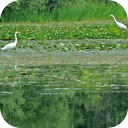(short preview of full seamless looping track)
(short preview of full seamless looping track)
(short preview of full seamless looping track)
(short preview of full seamless looping track)
(short preview of full seamless looping track)
River Bird Song
This product is not available in the selected currency.
In Stock
Backordered
Out of Stock
Description
Brilliant little birds tiptoe on the placid water, almost walking across as if they were lighter than air. You lay your blanket down on the riverbank and begin to release the week's tension, built up after hours spent under fluorescent lighting and the unforgiving glare of a computer screen. The soft sounds of grass and slowly moving animals in the brush beckon your soul to a more natural state and lull you into a sweet soft slumber. Bird vocalization includes both bird calls and bird songs. In non-technical use, bird songs are the bird sounds that are melodious to the human ear. The distinction between songs and calls is based upon complexity, length, and context. Songs are longer and more complex and are associated with courtship and mating, while calls tend to serve such functions as alarms or keeping members of a flock in contact. Most song is emitted by male rather than female birds. Song is usually delivered from prominent perches although some species may sing when flying. Some groups are nearly voiceless, producing only percussive and rhythmic sounds, such as the storks, which clatter their bills. The avian vocal organ is called the syrinx; it is a bony structure at the bottom of the trachea (unlike the larynx at the top of the mammalian trachea). The syrinx and sometimes a surrounding air sac resonate to sound waves that are made by membranes past which the bird forces air. The bird controls the pitch by changing the tension on the membranes and controls both pitch and volume by changing the force of exhalation. It can control the two sides of the trachea independently, which is how some species can produce two notes at once.
Opps
Sorry, it looks like some products are not available in selected quantity.



